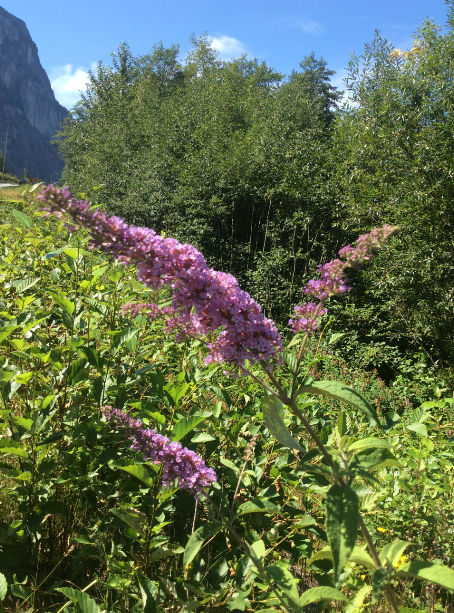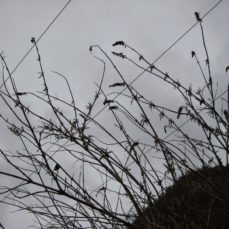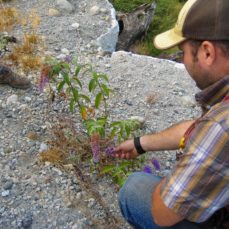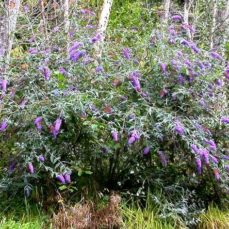Butterfly Bush
Buddleja davidii

Vectors of spread:
Synonyms
- Summer Lilac
- Orange Eye Butterfly Bush
- Buddleia davidii
ID Characteristics
General: Butterfly Bush is a rapid-growing deciduous shrub that is often planted in gardens to attract butterflies.
Flowers: Butterfly Bush has clusters of tubular flowers with four petals, that are arranged in dense pointed clumps at the end of branches. The flowers have an orange centre and are found in a variety of colours such as white, pink, purple, orange, red, and blue.
Stem: The arching stems can reach up to 5 metres tall. Young stems are green, while older stems are grey-brown and peeling.
Leaves: The leaves are semi-erect to falling, lance-shaped and 10 – 30 cm long. The upper leaf surface is deep green to blue-gray with a velvety texture, and the underside of the leaves is covered in short, fuzzy hair.
Fruits: Butterfly Bush produces small and ovate pods that become dark brown and open at the ends when they mature. There are about 500 – 1000 seeds per pod; seeds are small, lightweight, and winged.
Similar Species
Native
-

Photo credit: By Mark Robinson from Williton, UK – Pink CascadesUploaded by Austin512, CC BY 2.0, https://commons.wikimedia.org/w/index.php?curid=7374554
Red-flowering Currant (Ribes sanguineum): While Red-flowering Currant’s drooping flower clusters may be reminiscent of Butterfly Bush’s flower shape, the similarities stop there. Red-flowering Currant has lobed leaves and clusters of pink to deep red flowers, which become dark berries in the fall.
-

Photo credit: Dave Powell, USDA Forest Service (retired), Bugwood.org
Blue Elderberry (Sambucus cerulea): Blue Elderberry creates round clusters of creamy white flowers in spring.
Unlike Butterfly Bush, Red-Flowering Currant and Blue Elderberry are excellent choices for pollinator and bird gardens.
-

Fireweed (Chamerion angustifolium) has flowers located at the tips of stems like Butterfly Bush, but its flowers are less dense. Its fruits are longer and thinner than Butterfly bush.
- Hardhack (Spiraea douglasii) has smaller flowers that are 5 petaled.

Exotic
-

Source: Evergreen Nursery
California Lilac (Ceanothus spp.): There are about 50-60 species in this genus, which tend to have smaller shiny leaves than Butterfly Bush.
-

Source: University of Connecticut
Meyer Lilac (Syringa meyeri): Leaves are smaller than Butterfly Bush leaves (2 – 3 cm long), with slightly wavy margins.
Lilacs bloom in the middle of spring, while Butterfly Bush blooms later in the season, from June to September.
Invasive:
- Purple
 loosestrife (Lythrum salicaria) is often found at wetland sites. While its flowers are also pinkish-purple, they lack the orange eye that Butterfly Bush has.
loosestrife (Lythrum salicaria) is often found at wetland sites. While its flowers are also pinkish-purple, they lack the orange eye that Butterfly Bush has.
Report
Please report any sighting of Butterfly Bush by clicking here.
Habitat and Origin
Butterfly Bush originates from China and was introduced to North America as an ornamental plant. It remain a popular choice for those who wish to attract butterflies to their garden (see Ecological and economic impacts section for caveat).
As both a habitat generalist and a pioneering species, Butterfly Bush can withstand challenging environmental and climatic conditions such as full sun exposure and soil that is either low or high in moisture, as well as poor in nutrients. Therefore, this species can often be found in recently logged or burned forests, along railways, roadsides, cliffs, at building sites, on open or disturbed sites, and in riparian or coastal habitats.
Propagation & Vectors of Spread
Butterfly Bush reproduces both vegetatively and by seed. Butterfly Bush can sprout from broken branches, cut stems, or the rootstock. This plant matures quickly and can produce seeds within the first year of growth. One flower head can produce as many as 40,000 seeds, which remain viable in the soil for 3 – 5 years.
Butterfly Bush can attribute its global distribution to the horticulture trade. Once introduced to an area, seeds and plant fragments are dispersed by wind, water, vehicles, equipment, and machinery. Contaminated soil, sand and gravel also play a role in its dispersal.
Ecological and Economic Impacts
Ecological:
- Crowds out native vegetation by forming dense thickets
- Alters the nitrogen and phosphorous amounts in the soil, which displaces native species further.
- DOES NOT provide suitable habitat nor food sources for butterflies, as it only provides nectar for adult butterflies. Butterfly larvae cannot actually survive on Butterfly Bush. By competing with native vegetation that acts as a food source for the larvae, Butterfly Bush can actually have a negative impact on butterfly populations.
Economic:
- Impedes forest regeneration and disrupts patterns of ecological succession to ultimately decrease timber yields in the forestry industry.
What Can I Do?
Butterfly Bush is abundant in certain portions of the Sea to Sky region (i.e., Squamish and south), but has not yet infested all potential habitats. The goal is to contain the spread of Butterfly Bush to Squamish / ISMA 1.
Learn to identify Butterfly Bush: use the images presented on this profile page to learn how to identify Butterfly Bush.
What to do if you spot it: You can report any Butterfly Bush sighting by clicking here.
DO:
- Regularly monitor properties for weed infestations.
- Ensure soil and gravel are uncontaminated before transport.
- Ensure all plant parts are bagged or covered to prevent spread during transport to designated disposal sites.
- Since the seeds require exposed soil to germinate, minimize soil disturbances and use seed mixes with dense, early colonization (e.g. alfalfa or barley) to re-vegetate exposed soil and resist invasion.
DO NOT:
- Unload, park or store equipment or vehicles in infested areas; remove plant material from any equipment, vehicles or clothing used in such areas and wash equipment and vehicles at designated cleaning sites before leaving infested areas.
- Plant Butterfly Bush in a garden, no matter how well-contained its enclosure may seem.
- Compost any plant material. Instead, dispose of Butterfly Bush in the general/household waste stream at the landfill as the seeds will be able to survive the composting process.
- Move soil, gravel, or fill material that has been contaminated with Butterfly Bush.
Control:
Mechanical control
- Hand-pull small plants when the soil is moist.
- Remove larger bushes by cutting the plant at the base and digging up the stump, and then covering the stump with a thick plastic bag or mulch to prevent regeneration. Remove spent flower heads in the fall before seeds are dispersed.
- The best time to remove Butterfly Bush is during flowering, but before seed production has begun.
Chemical control
- Foliar application of herbicide containing triclopyr are somewhat effective for Butterfly Bush control, and only recommended for small plants.
- More effective treatments involve cutting the trunk of the plant off at the base and applying concentrated glyphosate or triclopyr to the cut surface (cut-stump method).
- We recommend that any herbicide application is carried out by a person holding a valid BC Pesticide Applicator Certificate. Before selecting and applying herbicides, you must review and follow herbicide labels and application rates; municipal, regional, provincial and federal laws and regulations; species-specific treatment recommendations, and site-specific goals and objectives.
Integrated control
Goat grazing may be effective with other control methods, but this treatment alone will not kill or eradicate Butterfly Bush.
Biological control
There are currently no biocontrol agents available for this plant.
References
- Brandywine Conservancy, Invasive species spotlight: The truth about Butterfly Bush https://www.brandywine.org/conservancy/blog/invasive-species-spotlight-truth-about-butterfly-bush
- Coastal Invasive Species Committee, Butterfly Bush, http://www.coastalisc.com/priority-invasive-plants/butterfly-bush
- Gardenia, Buddleja – Butterfly Bush, https://www.gardenia.net/plants/plant-family/buddleja_–_butterfly-bush
- Invasive Plant Atlas of the United States, Butterflybush, https://www.invasiveplantatlas.org/subject.html?sub=11608
- Invasive Species Compendium, Buddleja davidii (butterfly bush), https://www.cabidigitallibrary.org/doi/10.1079/cabicompendium.10314
- Invasive Species Council of BC, Blue Elderberry, https://bcinvasives.ca/play-your-part/plantwise/grow-me-instead/blue-elderberry/
- Invasive Species Council of BC, Butterfly bush, https://bcinvasives.ca/invasives/butterfly-bush/
- Invasive Species Council of BC, Red-Flowering Currant, https://bcinvasives.ca/play-your-part/plantwise/grow-me-instead/red-flowering-currant/
- King County, Butterfly bush identification and control, https://www.kingcounty.gov/services/environment/animals-and-plants/noxious-weeds/weed-identification/butterfly-bush.aspx
- Metro Vancouver Best Management Practices, https://metrovancouver.org/services/regional-planning/Documents/butterfly-bush-bmp-june-2023.pdf
- North American Butterfly Association, Butterfly Gardener, vol. 17, issue 2 (Summer 2012): The Great Butterfly Bush Debate, https://www.naba.org/pubs/bg172/bg172_Butterflybush_Issue.pdf
- University of Minnesota Extension, Black Chokeberry, https://extension.umn.edu/trees-and-shrubs/black-chokeberry
- Whatcom County, Control Options for Butterfly Bush, https://www.nwcb.wa.gov/images/weeds/Butterfly-Bush-Control_Whatcom.pdf




















